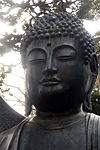Rochester Zen Center
| Rochester Zen Center | |
|---|---|
 | |
| Religion | |
| Affiliation | Independent |
| Location | |
| Location | 7 Arnold Park Rochester, New York 14607-2082 |
| Country | United States |
| Architecture | |
| Founder | Philip Kapleau |
| Completed | 1966 |
| Website | |
| http://www.rzc.org/ | |
| Part of a series on |
| Zen Buddhism |
|---|
 |
| Part of a series on |
| Western Buddhism |
|---|
 |
The Rochester Zen Center (RZC) is a Sōtō and Rinzai Zen Buddhist sangha in the Kapleau lineage, located in Rochester, New York and established in 1966 by Philip Kapleau. It is one of the oldest Zen centers in the United States.[citation needed]
History
Since its founding, the Rochester Zen Center has become one of the largest Buddhist centers in North America.[1] From those first twenty-two individuals, membership has grown to more than six hundred, with sitting groups and affiliate centers in Mexico and Germany, and throughout the U.S.[citation needed] In 1981 Rochester Zen Center community split, when Toni Packer left the Center.
The Rochester Zen Center has also contributed to the intellectual development of American Zen, through Philip Kapleau's books, The Zen of Living and Dying, Zen Merging of East and West, To Cherish All Life, and the recent Awakening to Zen and the writings of its members and its decennial anniversary conferences.[citation needed] In 1986, the 20th Anniversary Conference focused on "Buddhism and Nonviolence," and the 1996 Thirtieth Anniversary explored "Buddhism in America."
Since 1986 the head abbot at Rochester Zen Center has been Bodhin Kjolhede, who was sanctioned to teach by Kapleau.[2] The community offers intensive Zen sesshin retreats, introductory workshops and training programs throughout the year and is open to guests.[3]
Chapin Mill Buddhist Retreat
The Rochester Zen Center also has a 135-acre (0.55 km2) country retreat named Chapin Mill, donated by Ralph Chapin. Each year the center has several sesshin at Chapin Mill. The retreat center held a groundbreaking in April 2000. Building began in 2003, and was completed in 2007.
-
Dining hall facing kitchen.
-
Carved zendo door
-
Kannon Room
-
Facing enso, zendo on right carved door on left.
See also
References
Sources
- Farrer-Halls, Gill (2000). The Illustrated Encyclopedia of Buddhist Wisdom. Quest Books. p. 150. ISBN 978-0-8356-0786-5.
- Ryūken Williams, Duncan; Christopher S. Queen (1998). American Buddhism: Methods and Findings in Recent Scholarship. RoutledgeCurzon. p. 93. ISBN 978-0-7007-1081-2.
- Ford, James Ishmael (2006). Zen Master Who?: A Guide to the People and Stories of Zen. Wisdom Publications. p. 759. ISBN 0-86171-509-8.
- McDaniel, Richard Bryan (2015). Cypress trees in the garden : the second generation of Zen teaching in North America. Sumeru Press. ISBN 9781896559261.
- Kraft, Kenneth (1998). Zen, Tradition and Transition. Grove Press. p. 190. ISBN 978-0-8021-3162-1.
External links
![]() Media related to Rochester Zen Center at Wikimedia Commons
Media related to Rochester Zen Center at Wikimedia Commons










